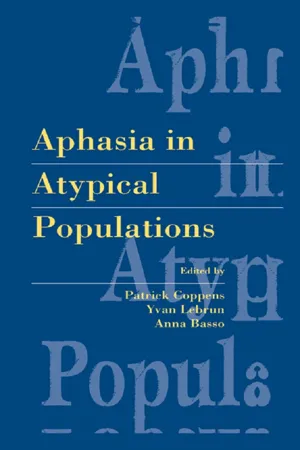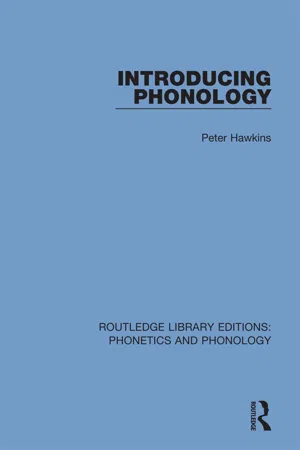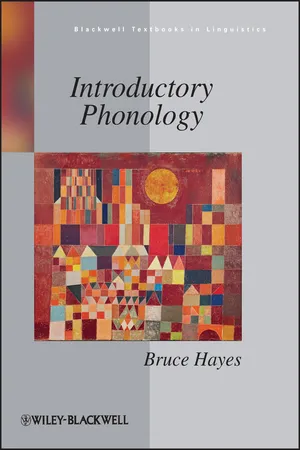Languages & Linguistics
Tone English Langugage
Tone in the English language refers to the attitude or emotion conveyed by the speaker or writer. It can be conveyed through the choice of words, phrasing, and overall style. Tone can range from formal and serious to informal and playful, and it plays a crucial role in shaping the overall meaning and impact of communication.
Written by Perlego with AI-assistance
7 Key excerpts on "Tone English Langugage"
- eBook - ePub
- Patrick Coppens, Yvan Lebrun, Anna Basso(Authors)
- 2012(Publication Date)
- Psychology Press(Publisher)
This is what is meant by lexical tones. Such languages are to be distinguished from those, such as English, in which pitch variations are usually not contrastive at the syllable or word level. In these nontone languages, however, differences in pitch patterns may be used to signal intonation at the phrase and sentence levels. The crucial feature that differentiates between these two types of languages is whether or not pitch variations are contrastive in the lexicon. All languages use pitch variations for intonation, but there are fewer possibilities in tone languages because of the use of pitch variations at the syllable or word level. Although there may be concomitant changes in duration and intensity, as well as phonation, the primary acoustic correlate of tones is generally regarded to be voice fundamental frequency (F 0) states and movements. For the purposes of this review, the important point to remember here is that hypotheses concerning hemispheric specialization for prosody couched in abstract, linguistic terms such as tone and intonation fail to account for the fact that all aspects of prosody beyond the word level are evident in all languages but to varying degrees. Tone languages are common in the Far East and Southeast Asia. Three of those languages are Mandarin Chinese, Cantonese, and Thai. A brief description of their tonal inventories is in order because the majority of studies to be reviewed in this chapter involve these languages. Mandarin Chinese has four lexical tones: level, rising, falling-rising, falling. Cantonese has six: high level, high rising, high-mid level, low level, low rising, low-mid level. Thai has five: mid, low, falling, high, rising. In Thai, for example, a set of five words can be minimally distinguished by tone: /khaa/, to be stuck; /khàa/, a kind of spice; /khâa/, to kill; /kháa/, to engage in trade; /khàá/, leg - eBook - ePub
- Peter Hawkins(Author)
- 2018(Publication Date)
- Routledge(Publisher)
7 IntonationIntonation is the name given to the fluctuations of pitch in spoken utterances. It normally refers to the pitch patterns of a larger grammatical unit such as a phrase, clause, or sentence, though of course a sentence may consist of only a single word, in which case intonation can apply to it. Intonation and stress are related phenomena (see above, p. 178) and, indeed, some writers use the term ‘sentence stress’ for what we shall call intonation.In this chapter our general aims will be: first, to present a concise, simple, yet adequate method for transcribing intonation, i.e. a suitable notation; second, to relate the pitch patterns to typical sentence functions such as statement, question, etc.; and third, to explore the role of intonation in grammatical structure, looking particularly at examples in which intonation resolves grammatical ambiguity.Basic featuresIntonation has three basic properties:1 It is a language universal. There are no languages which are spoken as a monotone, i.e. without change of pitch. In ‘tone’ languages, pitch change can be used to make a difference between one lexical word and another, in the same way that /p/ and /b/ differentiate pit and bit: in Chinese, which is a good example of a tone language, lán (high rising tone) means ‘blue’, but lăn (fall-rise tone) means ‘lazy’. Non-tonal languages, like English and most other European languages, do not make such lexical distinctions. In the tone languages, however, when the individual lexical items are combined into phrases and sentences, there still emerges an overall pitch ‘contour’ which is not simply the sum of the individual (lexical) tones, but carries the same functions as intonation in other (non-tonal) languages. So tone languages have intonation, but in addition the tones can be used to make lexical distinctions.2 Intonation is functional, - eBook - ePub
- Bruce Hayes(Author)
- 2011(Publication Date)
- Wiley-Blackwell(Publisher)
Very often, tone languages lack stress; this is apparently true for Igbo. It is also possible for tone and stress to coexist: Bantu languages often have a complex tone system coexisting with a simple penultimate stress pattern.15.1.2 Intonation languages
In an intonation language, pitch does not distinguish words. Instead, there are phrasal-level pitch patterns which convey abstract meanings of their own, usually related to the information structure of the utterance. English and most other European languages are intonation languages. It is typical for an intonation language to have stress.The pitch tracks in figure 15.2 show the English word animal [ˈænəməl] as pronounced by the author using statement, then question intonation. The first and last syllables are shown linked to phonological tones, which will be explained in the discussion to follow.15.1.3 Pitch accent languages
Pitch accent languages are something of an intermediate case. Pitch is phonemic (distinguishes words), and so there are minimal or near-minimal pairs for pitch. Pitch accent languages differ from pure tone languages in that words can only have one prominent syllable. This syllable serves as the anchor point for a pitch change, and pitch in the remainder of the word is predictable, or determined intonationally. The limitation to one prominent syllable is reminiscent of the principle of culminativity in stress (§14.2.1.1).English intonationFigure 15.2Tokyo Japanese is a well-studied pitch accent language. Here, one particular syllable in a word can bear a high tone. The choice of which syllable (if any) bears high tone is unpredictable, and high tones must therefore appear in lexical entries. The pitch on all remaining syllables is predictable and can be derived by tonal insertion rules (see Further reading). In addition, many words of the Tokyo dialect have no underlying high tone; for these, all of the tones that appear on the surface are phonologically inserted. - eBook - ePub
The Sounds of Language
An Introduction to Phonetics and Phonology
- Elizabeth C. Zsiga(Author)
- 2012(Publication Date)
- Wiley-Blackwell(Publisher)
This chapter follows up on Welmers’ assertion by discussing tone as a phonological system. Section 17.1 discusses contrasts, alternations, and representations in tone languages. Section 17.2 discusses intonation, the use of pitch to convey discourse meaning, which both tonal and non-tonal languages exhibit.Various aspects of tonal phonetics and phonology have been touched on in earlier chapters:Chapter 4.6: definition of tone and intonation; transcription of contrastive tone Chapter 5.3: laryngeal anatomy and control of F0 Chapter 8.2.2: making pitch tracks Chapter 9.3.1: pitch perception Chapter 13.4: basics of the autosegmental representation of toneIn this chapter, we build on these introductory notes to create a fuller picture of tonal and intonational phonology.17.1 Tone
17.1.1 Tone Contrasts
Tone is the use of pitch to create lexical contrast. In a tone language, two or more words can have identical segments, but differ in meaning because they are produced with a different pitch pattern. In the simplest tone system, each syllable is produced with either relatively high or relatively low pitch. Such a system is exemplified by many Bantu and Athabaskan languages, including Setswana (1) and Navajo (2). High tones are marked with an acute accent on the vowel; low tones with a grave accent.(1) Setswana tone contrasts:a. Two patterns on monosyllables:High Low xá his xà not ú- s/he ù- you (sg) (2) Navajo tone contrasts:b. Four patterns on disyllables:
Note that, in Setswana, syllabic nasals may bear tone, indicating that tone is not just a property of vowels (see Section 17.1.2 below). Yoruba (Nigeria) and Punjabi (Pakistan) are typical of the many languages that contrast high vs. mid. vs. low tones. (3) Yoruba tone contrasts: three levels: (4) Punjabi tone contrasts: three levels:High Low jí he jìs I Figure 17.1 graphs the F0 patterns of the three Yoruba tones. It is not the case that pitch is absolutely flat over the course of the syllable, but the contrast is between relative pitch heights.Figure 17.1 Three tones in Yoruba.Source: Gandour, J. 1978. The perception of tone. In V. Fromkin (ed.), Tone: A Linguistic Survey - D Westermann, Ida C. Ward(Authors)
- 2015(Publication Date)
- Routledge(Publisher)
tone languages.Tone Languages.402. A tone language is one which makes a particular use of pitch as an element of speech. This special use consists in the employment of pitch for two purposes, viz.(1) to indicate meaning (semantic or etymological tones); (2) to show grammatical relationships (grammatical or syntactic tones). Semantic or Etymological Tones.403. Words alike in all other respects, but differing in tone are different in meaning, the pitch alone indicating this difference: thus pitch is significant.1404. EXAMPLESEfik.Ibo.akpa river akpa first akpa he diesmmɔŋ water mmɔiŋ where ?ekere didie ? What is your name ?ekere didie ? What do you think ?Kpelle.isismell isihead isisix ibεplace ibεcompanion ɔnε εbu ibu he is carrying loadsɔne εbu ibu he is fatChuana.nyahe nyeI nyεhe said nyεI said ŋɔhis part ŋɔmy part Ewe.buato skin buato speak Duala.havia young pig havifriend Yaunde.mbɔtigarment mbɔtiunripe bananas yato come yato give birth kokato dry kokato grow For further examples, see the phonetic summaries of special languages at the end of the book. Grammatical Tones.nɔŋto take nɔŋto rain bɔthey bɔto make ayaŋbulbous plant ayaŋkind of snake 405. Grammatical forms in some languages are indicated by tone alone.406. EXAMPLES- eBook - ePub
- Gillian Brown(Author)
- 2017(Publication Date)
- Routledge(Publisher)
The aspect of intonation which has traditionally been, and is still, most extensively studied is that of the perceived variation in pitch level, particularly in the pitch patterns on the tonic word and what follows it in the same tone group. The difficulty which faces anyone working on this aspect of intonation is deciding what, from the mass of phonetic data, constitute regular and systematic patterns. It is like the problem which confronts the phonologist when trying to make a phonemic transcription of normal informal speech—how is the phonetic realization which contains 'distorted' (assimilated) or even missing segments, or parts of segments distributed over neighbouring sounds (as when a nasal is realized by nasalization on the preceding vowel) to be related to the 'ideal' structure of the word intended by the speaker? The student of intonation has an even more difficult task than the segmental phonologist because there are many models of English intonation and they bear rather little resemblance to each other: at least phonologists tend to agree on what a phonemic representation of an ideally pronounced word should look like. Phonologists concerned to describe intonation may describe it in terms of a number of pitch levels (which sometimes assimilate to form contours) or a number of basic contours. If they choose a number of basic contours, that number may range from a large number, through smaller numbers like seven, five, three down to two—two is probably the most common.Let us consider some data (though I should point out that I am not actually offering you 'data' but my transcription, that is, my analysis, of data). Once again I shall assume that the 'ideal' tone patterns are used by newsreaders reading the first, uncontextualized, sentence of a news item. This assumption can, I think, be justified in the description of 'academic' speech which is primarily concerned with the communication of 'intellectual' facts within the framework of a coherent structure of discourse. It would certainly be much less appropriate in the description of 'conversational' speech. The reader should note at this point that the stress and intonational devices which we have considered so far are common to all native accents of English no matter where in the world they are spoken. All native speakers of English stress lexical items, divide their utterance into tone groups marking syntactic units, and mark the head word in the tone group by the tonic. Tone on the other hand varies very much between accents, very markedly so even within the accents spoken in Britain, and, within accents, varies to some extent with the individual. It is a curious and surprising fact that it is this highly variable intonational factor which has received so much attention, at the expense of the comparatively stable factors which we have examined in the previous sections.Extract 1
There's been a sharp reac tion in the CI ty +to the Bank of England's WAR nings +about the dan ger of inFLA tion + +Comment
The three tone groups here share a very similar tonal pattern. The unstressed syllables at the beginning of the tone group are uttered on a mid-low tone. With the first stressed syllable in each case—sharp, Bank and dan(ger) —the tone jumps sharply to fairly high in the voice range. There is then a gradual descent through unstressed and stressed syllables until the tonic syllable when the pitch of the voice rises at the beginning of the tonic and either falls sharply to fairly low on the next syllable when there is a medial voiceless consonant as in the case of city and inflation or falls gradually to fairly low when the tonic word is fully voiced as it is in warning. The amount of movement from fairly high to fairly low is most marked on the final tonic, inflation. - Weifeng Han, Chris Brebner(Authors)
- 2023(Publication Date)
- Routledge(Publisher)
In addition, tone is also a prominent cue to speaker identity and prosody, creating an important challenge for listeners. Lexical tone is a prevalent phonetic cue in human language, but poorly understood in bilingual language processing, in particular, when one language does not use tone, like uni-tonal bilinguals (e.g., Mandarin–English bilinguals). To date, the majority of research has primarily focused on segmental information (e.g., phonemes) in triggering cross-language lexical activation and competition; it remains underexplored whether and to what extent supra-segmental information (e.g., lexical tones) would affect word recognition in tonal bilinguals (Wang, Wang, & Malins, 2017). Figure 2.1 Mandarin tones. In light of this research gap in the literature, two recent pioneering empirical studies have investigated the role of lexical tones in bilingual lexical access and how it modulates language (non)selectivity (Wang, Hui, & Chen, 2020 ; Wang et al., 2017). In two auditory lexical decision tasks in English, Wang et al. (2020) show that Mandarin–English bilinguals responded to interlingual homophones (IHs) (e.g., bay which has an interlingual Mandarin counterpart 被 “quilt” pronounced as /bei4/) slower than control distractors (non-IHs) (e.g., boy which does not have an interlingual counterpart), only when the tonal information was present in the stimuli. Here, similar to Schulpen et al.’s study, the IH inhibitory effect was interpreted as cross-language lexical competition. In the first experiment, the bilinguals responded to both types of stimuli in a similar fashion (i.e., there were no IH effects), suggesting language-selective access because the segmental level overlap between English and Mandarin failed to elicit cross-language competition, in contrast to previous findings in non-tonal bilinguals (e.g., Spivey & Marian, 1999 ; Ju & Luce, 2004 ; Weber & Cutler, 2004)
Index pages curate the most relevant extracts from our library of academic textbooks. They’ve been created using an in-house natural language model (NLM), each adding context and meaning to key research topics.
Explore more topic indexes
Explore more topic indexes
1 of 6
Explore more topic indexes
1 of 4






